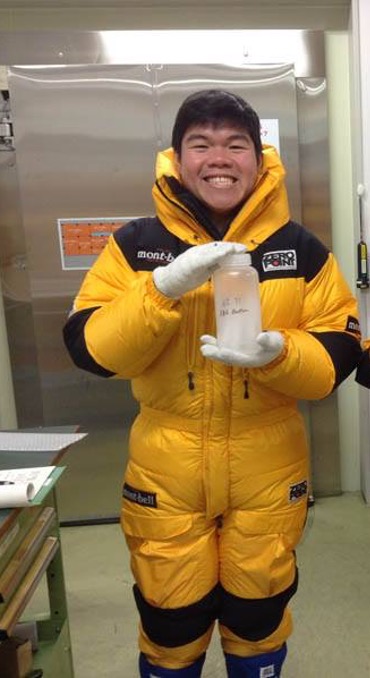

Left: DOST-PNRI’s Dr. Angel Bautista VII presents a segment of the ice core containing the I-129 radionuclide signals which they propose as the most probable golden spike indicator of the Anthropocene epoch
Right: Sampling the ice core at the SE Dome site in Greenland
Scientists discover nuclear signals that could
possibly mark the start of the Anthropocene
When did human activities start affecting the earth permanently on a planetary scale? This proposed new period of such human activities is called the Anthropocene epoch. This period, and all other periods such as the Jurassic Age, has a start flag called the “golden spike,” an event marker that signals a tremendous physical, chemical, or biological change across the Earth.
In a new study by DOST-Philippine Nuclear Research Institute, The University of Tokyo, RIKEN, Hirosaki University, and Hokkaido University, researchers propose that the beginning of the Anthropocene, or its “golden spike,” is best recorded as nuclear bomb peaks.
In particular, the scientists found the peaks of the radionuclide iodine-129 or I-129 found in an ice core at the Greenland Southeast Dome site as an “excellent candidate for the Anthropocene period’s golden spike.”
Scientific debate
Identifying the Anthropocene’s golden spike is a comprehensive scientific debate that started in 2009 and has been ongoing for years. A growing consensus within the scientific community is that the most pronounced global start of the Anthropocene is within the mid-20th century. Called the “Great Acceleration,” it is a period of exponential human population, economic, and technological growth at a scale that caused massive changes in the Earth’s environment.
Quest for the golden spike
Scientists have explored several probable golden spikes in the Great Acceleration. Among those considered are the global fallout signals from nuclear weapons testing, particularly of the radionuclides carbon-14 (C-14) and plutonium-239 (Pu-239). However, these radionuclides will decay and disappear a few hundred thousand years into the future, and their signals will be impossible to be found by humans by then. Thus, they may not be quite enduring to serve as the golden spike.
In their quest, scientists found a more fitting golden spike indicator-- iodine-129 (I-129) whose half-life is 15.7 million years, which means that its signals can be found by humans even millions of years into the future.
Ice recordings
The authors in this study measured I-129 in ice deep in the Greenland Southeast-Dome site, even as they explored its potential as the likely Anthropocene golden spike.
As they took the core out from the 90-meter deep ice drilling, the researchers found that the I-129 in the ice core recorded almost the entire history of the nuclear age, particularly the period 1957-2007. “It was in unprecedented detail at a resolution of about every four months,” the scientists say.
More specifically, the I-129 in the ice core recorded signals from nuclear weapons testing in 1958, 1961, and 1962, the Chernobyl Accident in 1986, and other various signals from nuclear fuel reprocessing within the same year or a year after. The relationships between I-129 in the ice core and these human nuclear activities were defined and quantified through a mathematical model.
Most importantly, these I-129 nuclear signals were also seen in other records from different locations and environments worldwide, such as in trees, corals, and sediments. This means that these signals can be found virtually anywhere – a good characteristic of a potential golden spike. This global presence is comparable with those of the C-14 and Pu-239 bomb signals, but the much longer half-life of I-129 makes it a more enduring and ideal golden spike.
The study was published in Science of the Total Environment, one of the world’s leading environmental science journals with an impact Factor of 10.75.
(By the Nuclear Materials Research Section, DOST-PNRI)

Segment of an ice core












































